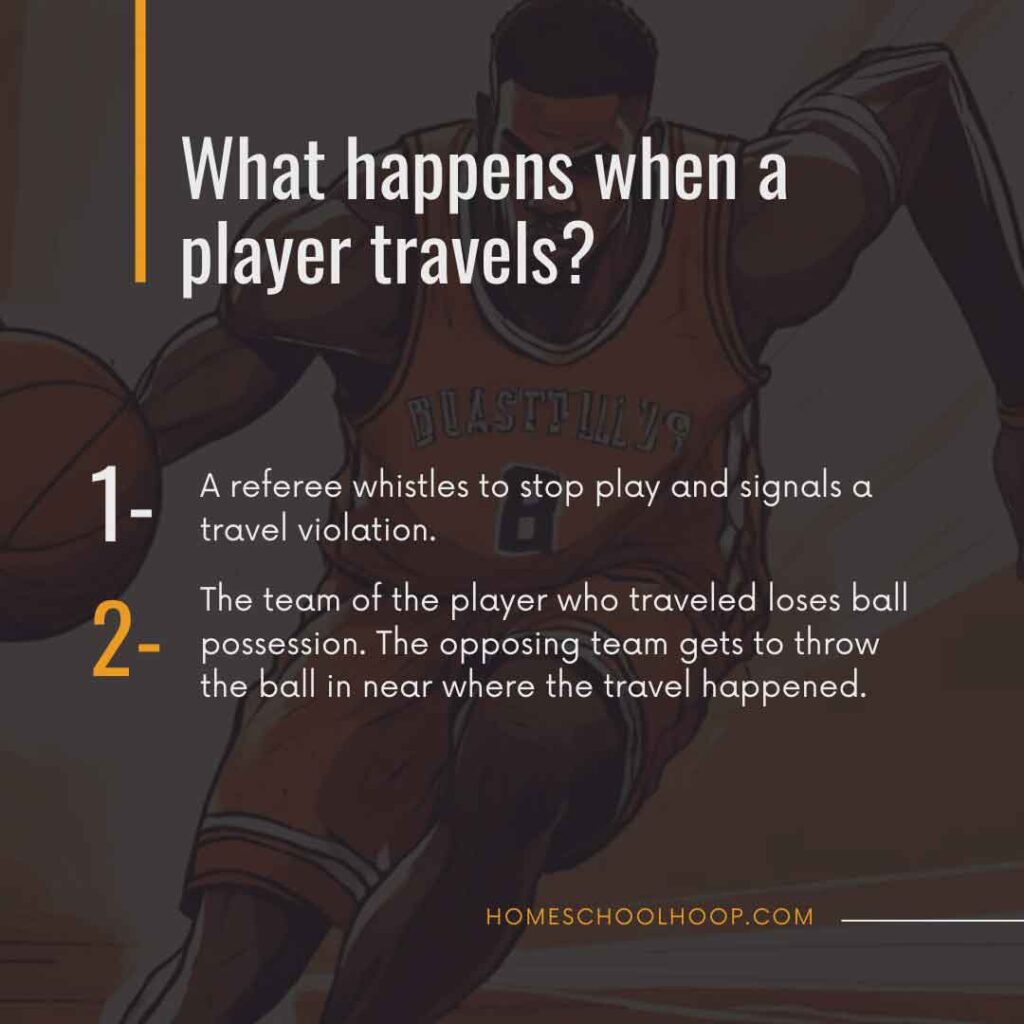Ever seen a player make a great move, only to have it dismissed for ‘traveling’? Traveling in basketball is a common violation, but it is often not well understood.
Key Takeaways:
- Traveling in basketball is when a player illegally moves with the ball without proper dribbling.
- Only a player with the ball can be called for travel.
- A traveling violation results in a turnover, and the ball is awarded to the other team.
Traveling in basketball is a violation that shapes a team’s offensive efficiency and the game’s flow. Understanding it is important to both playing well and enjoying the game.
In this article, we’ll break down what traveling really means, clear up common confusions, explain why it’s important, and share tips to avoid being penalized for this common mistake.
What is Traveling in Basketball?
Simply put:
Traveling in basketball is a violation that happens when an offensive player moves their feet illegally while holding the ball.
Usually, this means taking too many steps without dribbling.
Here’s the basic idea: when you have the ball, you pick a pivot foot, which is a foot that stays in place. You can’t move this foot until you pass, shoot, or dribble the ball.
If you take more than two steps without dribbling, that’s traveling. This is a rule in all basketball leagues (NBA, WNBA, NCAA, FIBA, high school, etc.), though some details might differ a bit from one league to another.
Traveling can happen in different ways. But here are the major points to remember:
- Only the player with the ball can travel.
- Traveling is all about moving your pivot foot illegally.
- You can’t travel while you’re dribbling.
- You don’t need to be on the court (in bounds) to travel. Sometimes you can travel when inbounding the ball.
In basketball, you might also hear traveling called “walking” or “taking steps.” Another term is “up and down,” which is when a player jumps and lands without passing or shooting, and that’s also traveling.
Learn more: What are field goals in basketball?
Importance of The Pivot Foot
The pivot foot plays a crucial role in basketball offensive play, especially in avoiding traveling violations and turnovers.
Think of the pivot foot as your anchor on the court. When you’re holding the ball and not dribbling, you establish one of your feet as the pivot foot. This foot has to stay planted on the floor until you pass, shoot, or start dribbling. If it doesn’t, you risk a traveling call.
Here’s how it works:
- Choosing the Pivot Foot: As soon as you stop dribbling and hold the ball, one foot becomes your pivot foot. If you land on both feet at the same time without dribbling, either foot can be chosen as the pivot.
- Moving the Pivot Foot: You’re allowed to turn or spin on your pivot foot, but lifting it off the floor or sliding it before dribbling, passing, or shooting counts as traveling.
- Switching the Pivot Foot: Once you’ve established a pivot foot, you can’t switch to the other foot. If you do, that’s traveling.
Using the pivot foot correctly is the only way to master skillful offensive play. It allows you to move strategically while staying within the rules of the game.
Common Misconceptions and Errors Involving the Pivot Foot
There are several common mistakes and misunderstandings about the pivot foot that players often encounter:
- Lifting the Pivot Foot Too Soon: It’s a common mistake to lift the pivot foot off the ground before passing or shooting. The rule is the pivot foot must stay down until the ball is passed or the shooting motion begins.
- Changing the Pivot Foot: You can’t switch your pivot foot once it’s established. Trying to do so during a play will result in a traveling violation.
- Pivot Foot and Dribbling: Some think you can move the pivot foot as you start to dribble. But actually, the pivot foot must remain stationary until the ball leaves your hand.
- Pivot Foot in Jump Stops: When landing on both feet together (jump stop), either can be the pivot. But, once established, the usual pivot foot rules apply.
- Pivoting After Stopping Dribble: Some players think that you can pivot indefinitely after stopping your dribble. In reality, once the dribble stops and a pivot foot is established, your movement is restricted.
Why is Traveling Illegal?
Traveling has been off-limits since basketball’s early days. James Naismith, the creator of basketball, listed traveling as one of his original 13 rules.
Here’s the scoop on why traveling is a violation:
- Keeping it Fair: The main reason for the no-traveling rule is fairness. It stops players from gaining an unfair offensive edge by moving wrongly with the ball. This rule gives the defense a chance and makes sure no one gets to move too far while holding the ball and not dribbling.
- Game Consistency: Traveling, like other rules such as double dribble or backcourt violation, keeps the game consistent. Players need to move the ball in a set, accepted way.
- Focusing on Skills: With rules like traveling in play, basketball becomes a game where skill, strategy, and teamwork shine. It’s not just about who can run fastest with the ball, but who’s most skilled and plays smartest.
In short, the traveling rule is there to ensure a fair and structured game where everyone plays by the same standards.
Penalties for Traveling

When a player travels, the game is impacted in a few key ways. Here’s what happens:
- Referee’s Call: When a player travels, the referee blows their whistle to halt the game. They then make a circular motion with their arms, signaling a travel violation to everyone watching.
- Turnover: The team of the player who traveled loses possession of the ball. The opposing team gets to throw in the ball near where the travel happened. The player who traveled is noted in the stats as having made a turnover.
Traveling violations can really change the course of the game. They stop a team’s offensive play, often when they’re in a good position to score. This not only costs the team possession of the ball but also a chance to add points to the scoreboard.
Examples of Traveling Violations
There’s not only one way to get a travel call. Here are some common ways players travel:
1. Moving Before Dribbling
The most common instance of traveling in basketball is taking a step with the basketball before the ball has left your hand for a dribble. The ball must be out of a player’s hand and on the way down before picking up the pivot foot.
2. Pivot Slides
When a player slides or drags their pivot foot along the floor without dribbling, it’s a travel. This often happens when a player is under pressure. The pivot foot needs to stay in one spot.
3. Up and Down
This is when a player jumps with the ball, usually with the intention to shoot or pass, but lands with the ball still in their hands.
4. Falls to the Floor
This happens when a player with the ball loses their balance and falls over, subsequently lifting their pivot foot, before releasing the ball.
5. Extra Steps
Taking more than two steps into a layup is traveling. This often happens after misjudging the distance to the basket or when trying to get around defenders.
6. Getting Up Off the Court
A player lying or kneeling on the court with the ball cannot legally stand up with the ball unless they’re dribbling. Otherwise, it will be called a traveling violation.
7. Switching the Pivot Foot
Once a player establishes their pivot foot, they cannot change it. Oftentimes you’ll see this with younger or newer players, where defensive pressure causes them to forget the foot they’ve established.
8. Shuffle Steps
This occurs when a player shuffles their feet before starting to dribble or while trying to create more space for an open shot.
Note: A travel is different from a carry in basketball. A carry involves the ball-handler slipping their hand underneath the ball to temporarily pause their dribble.
Enforcement of Traveling Rules
Enforcing traveling in basketball is all up to the referees, and it can be tricky. They have a big job catching these violations, and if you’ve watched a game then you know – they don’t catch every single travel.
The referees need to watch every player closely, not only the player with the ball. Plus, the game moves fast, and sometimes illegal movement violations are missed.
Also, leagues like the NBA, WNBA, NCAA, and FIBA may enforce traveling a bit differently. For example, the NBA is notoriously lenient with traveling, particularly by the league’s top players. Whereas, leagues like the WNBA and FIBA are stricter.
And while technology like instant replay is available today to help referees make the right calls for a limited set of situations, the rules don’t allow them to review a travel call.

Tips to Avoid Traveling
Do you keep getting called for traveling? Here are some tips and drills to focus on:
- Footwork Drills: Start with basic footwork drills to build muscle memory. Toss the ball to yourself and catch it with either a one-two stop or two-foot jump stop while establishing a pivot foot. Practice keeping it in place while pivoting, jabbing, and pump faking.
- Pivoting Techniques: Drills that involve pivoting and passing or shooting can help you understand how to use your pivot foot without traveling.
- Slow Down: Oftentimes players travel when they try to move too fast or do multiple different things and end up with illegal movement or footwork errors.
- Game-Like Scenarios: Use drills that mimic game situations. This helps players apply the rules of traveling in the context of a real game, making it more instinctive. Organizing a basketball scrimmage with referees can also be helpful.
The Euro-Step and Its Legality
The Euro-Step is a popular offensive move, but its legality often raises questions about traveling. Here’s what you need to know:
What is the Euro-Step?
It’s an offensive move where the ball handler takes a step in one direction and then quickly steps in the opposite direction, all while advancing toward the basket. This is typically done to evade defenders and get closer to the basket for a layup.
Legal or Not?
The key is in the steps. When done correctly, the Euro-Step involves just two steps after the last dribble, making it a legal move. It’s about timing and foot placement.
To avoid traveling, players need to release the ball for a shot or pass before the foot of the second step touches the ground. If they take more steps or delay the pass or shot, it becomes traveling. When executed within the rules, it is a legal and effective move in basketball.
Understanding Different League Rules
The basketball traveling rule is generally consistent across various leagues. But, there are some minor differences.
Gather Step
FIBA rules and NBA rules on traveling are slightly different from other leagues in that officials allow for a “gather step.”
A gather step is a third step that offensive players can take after they pick up their dribble. The first step, often referred to as the “zero” step, can be followed with two additional steps in any direction when coming to a stop, passing, or shooting the ball.
The gather step is considered a travel violation at the high school and college levels. The NBA unabashedly prioritizes offense, and the league’s unique rule around this allows players to more easily position themselves to be an offensive threat.
FAQs
What is traveling in basketball?
Traveling is when a player moves illegally with the ball without proper dribbling, or doesn’t establish a pivot foot correctly. It results in a turnover in basketball.
How many steps is a travel?
Taking more than two steps without dribbling the ball is considered traveling.
How many steps can you take in basketball?
You can take up to two steps in basketball while moving with the ball, after which you must either pass, shoot, or dribble.
Is 2 steps a travel in basketball?
It depends on the situation. Taking two steps while gaining control of the ball or while progressing to shoot is not a travel. However, if you already have one foot on the floor when you receive the ball, you only get one extra step.
Can you take 2 steps after catching the ball?
Yes, you can take two steps after catching the ball, as long as you either shoot or pass before the foot of the second step touches the ground.
What is a walk in basketball?
A walk in basketball is another term for traveling. It refers to moving illegally with the ball without proper dribbling.


